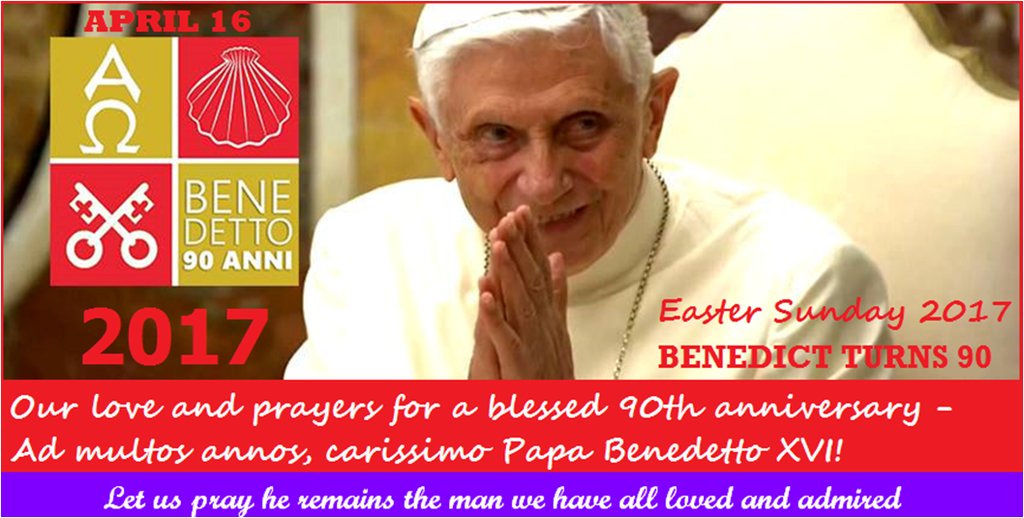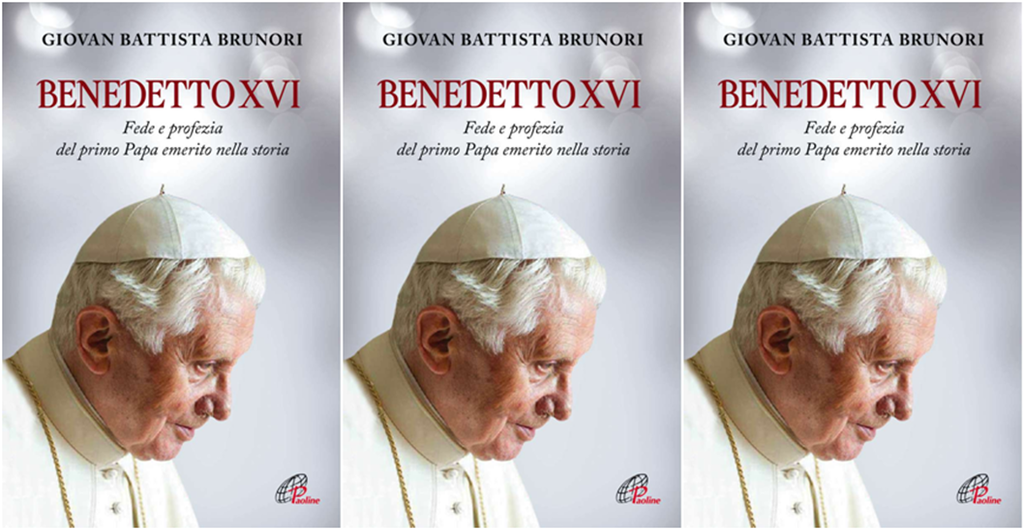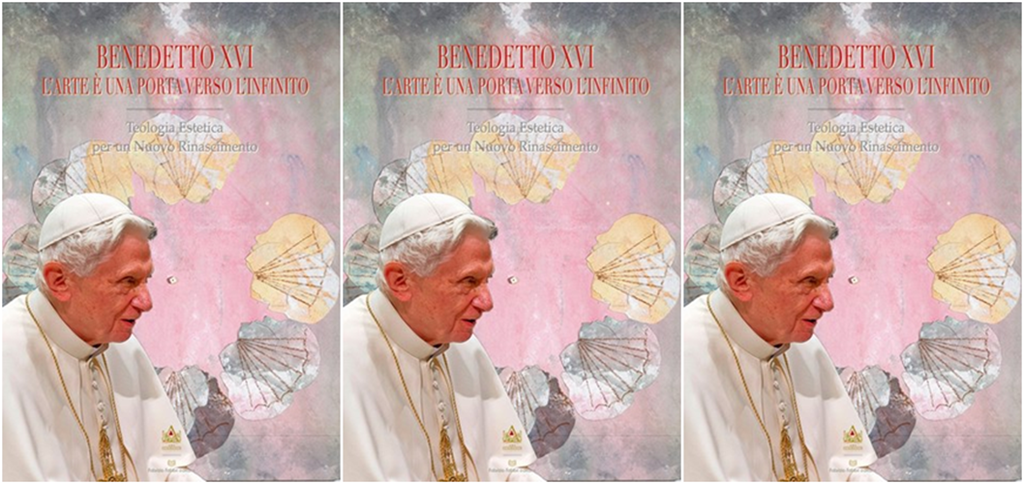 Benedict XVI:
Benedict XVI:
The prophecy of faith
by Angela Ambrogetti
Translated from

ROME, April 19, 2017 (ACIStampa) – One of the most significant aspects of the life of Joseph Ratzinger was his work as Prefect of the Congregation for the Doctrine of the Faith. Without that almost quarter-century of work, his pontificate as Benedict XVI would have been very different.
This was well understood by Giovan Battista Brunori, Vaticanista of Tg2 (the primetime newscast of Italian state TV’s second channel), who had a solid preparation as archivist and has also been in charge of foreign affairs for the RAI editorial department.

His book,
Benedetto XVI. Fede e profezia del primo Papa emerito della storia” (Benedict XVI: Faith and prophecy of the first Emeritus Pope in history) (ed. Paoline, 2017), is invaluable for reporting his bibliographical references, and other notes and citations which make it a true instrument for study, even for other journalists.
As Brunori explains it in his introduction,
“To a world that is increasingly uncertain and fearful, that has been thrown into a crisis of identity by mass migrations, embittered and constrained to defend itself from the threatening hatred of terrorists who are passing off their perceived ‘duty to kill’ as their ‘duty to believe’, Ratzinger’s response was to present to everyone ‘the Christian difference’ which love, the true face of Christianity. ‘God is love’, he reaffirmed in his first encyclical, taking off from the evangelist John. This is the key to understanding the ‘prophetic’ quality of Joseph Ratzinger’s life."
One simply needs to look through the Table of Contents to see how this prophetic quality has emerged. From his life in his native Bavaria, through the Second World War, his formation as a priest, his work as a professor, in the Second Vatican Council, and especially, his work at the CDF.
Brunori notes, “Ratzinger committed many years of his life in seeking to renew it and make it more international, calling on theologians and canonists from all over the world to work with the CDF. Durign his term in office, he carried out service which changed the Church”.
The text cites the most difficult issues faced by the Bavarian cardinal at the CDF, but also includes his clear but respectful working method as the theological and doctrinal right-hand man of John Paul II. A method that also shaped and reflected what would be Benedict XVI’s spiritual program.
“Few appreciated that Benedict XVI was not interested in making political statements but in transmitting spiritual messages that indicate the way for the Church to return to the essentials of the faith."
One could see this in his papal coat of arms which signaled a discontinuity with the past (it does not use the image of the papal tiara), in that it indicates a pope who did not think of himself as ‘a successor of Emperor Constantine’ but of a fisher of men” as Peter was.
And few are aware, Brunori says, of the breadth of the dialog that Benedict XVI carried on – with those unused to thinking of faith and reason as compatible and inseparable, with thinkers from other confessions and from other faiths.
Whereby he reports on the Regensburg lecture in its real sense:
“The Regensburg lecture – despite all the opposition, errors and controversy it stirred up – was a turning-point, a change from the tendency to the irenism that usually characterizes inter-religious relations, in which a kind of false courtesy takes over, so that dialog becomes nothing but an exercise in good manners and fine-sounding words that last only as long as the news spotlights are on, but really does not stick to the consciousness of the participants and their followers”.
After Regensburg, in Paris, London and Berlin, the great September secular discourses of Benedict XVI conveyed to the world his vision of the faith, with particular application to the European experience.
But there is also an
ad intra analysis of his pontificate regarding the difficulties in his relationship with the Roman Curia some of whose elements, in some way, viewed Benedict XVI with suspicion.
[Hostility is perhaps the more appropriate word, because ‘suspicion’ can imply some degree of collaboration, however reluctant – whereas the few overt elements who worked proactively against him (the Vatican Old Guard from the previous pontificate, along with a few influential progressivist retired cardinals living in Rome, who saw in him their nemesis because of his implacable rejection of the erroneous but stubborn ‘spirit of Vatican II’) sought to sabotage his efforts when they could, and as they could.]
But Benedict proceeded with his program – renewing Catholic thought, fruitful dialog with the right parties (like the Anglicans he welcomed back to the Church in the Ordinariates), consolidated special relations with the Jews, held out a hand to the excommunicated Lefebvrians.
“Benedict’s understanding of the Biblical Israel”, writes Brunori, “was part of his research into the sources of the Christian faith. The Jews of the Bible were almost like a ‘traveling companion’ for Ratzinger – for whom the Christian faith would not be properly understood without what came before it. That the relationship with the Jewish people is part of the Church’s path, and that the renewal of the faith that he aspired to was impelled by his own Biblical formation, by his study of Sacred Scriptures, both the Old and the New Testaments”.
And so, Brunori comes naturally to a conclusion after a careful reconstruction of many facts:
“The outwardly ‘timid’ Pope, gifted with strong and brilliant thinking, who proposed rather than seeking to impose, who would have preferred not to become a bishop nor Curial official, who did nothing to become Pope, really prefers a life of reserve, yet more than any other prelate in our time willingly exposed his person to criticism and insults.
He publicly acknowledged the errors committed by the Curia in the same way that he never hid his human frailty, yet he did not draw back from dealing with the recurrent tempests that afflicted the Church during his Pontificate”.
His renunciation of the Papacy was simply the final step in a life of prophecy. Brunori’s book takes the reader beyond the superficial chronicle of daily headlines to bring a clarity to the work and achievements of the 265th Pope.
Just when I thought I had caught up with the new books on B16, Vatican radio turns up another one today – this time a book that pays tribute to Benedict XVI’s
relationship with the arts. Its very title is programmatic: “Benedetto XVI. L’Arte è una porta verso l’infinito. Teologia Estetica per un Nuovo
Rinascimento” (Benedict XVI: Art is a door to the infinite. An aesthetic theology for a new Renaissance)
 A book honors Benedict XVI’s
A book honors Benedict XVI’s
appreciation of the arts
Translated from the Italian service of

April 22, 2017
A tribute to Benedict XVI for his 90th birthday and to his constant invocation of the theme of beauty as a way of evangelization. This is the book
Benedetto XVI. L’Arte è una porta verso l’infinito. Teologia Estetica per un Nuovo Rinascimento” (Benedict XVI: Art is a door to the infinite. An aesthetic theology for a new Renaissance).
Published by Fabrizio Fabbri Editore and Ars Illuminandi, and edited by Mons. Jean Marie Gervais, founder of the association Tota pulchra (All beauty), and journalist Alessandro Notarnicola, the book was presented Saturday morning at the Palazzo della Cancelleria in Rome, and contains the most significant texts of Benedict XVI on the arts. It is illustrated by the artist Bruno Ceccobelli.
RV’s Paolo Ondarza interviewed co-author Notarnicola who spoke about why the book was put together:
Notarnicola: I think of this book as a true and proper biography – I like to think an original one – of the Emeritus Pope because it puts together his thoughts on the arts and on beauty, written when he was cardinal as well as after he became Pope. We all know that Pope Benedict made numerous references to beauty – both the material artistic beauty which we all experience and see in churches everywhere, but especially, at the Vatican; and the beauty of nature, of Creation, what God has given man.
The book does not consider beauty as abstract and remote from man’s affairs, and within the book, Benedict XVI is often cited telling artists that “Mankind needs beauty – beauty can give us courage and encouragement”. Which makes it very immediate…
Yes. The Emeritus Pope explains that one of the ways by which man can carry out his continuous search for the infinite which conflates with the
imago Dei and therefore ends in God himself, is art which should not simply be something beautiful – it must not be empty. It does not end with the tourist who comes into a church, admires the works of art he sees and photographs them – but that each work of art has a message. Art is a bridge between reality, the life of each of us, and the transcendent – God. Substantially, we can say that every work of man should be a work of art.
In his eight years as Pope, rich with content that we ought to be studying constantly, Benedict XVI underscores two points about beauty. On the one hand, art, beauty, the union between the
via veritatis, our continuous search for truth, and the
via pulchritudinis, our search for truth. On the other hand, we must not forget that Benedict XVI was conscious of beauty even in his reference to the new technologies, having been the first pope to use the social media. In this, he sought to make it clear that art can be lived even through the Internet, that the social networks should not be vacuous initiatives that are simply vehicles for vanity, like the selfies that are posted on Instagram. They can be used to propagate ethical principles ‘artfully’ – art for evangelization. And so, as Paul VI did in 1964, he called on artists to evangelize through their talents because God ought to be present in everything, including works of art.
Against the prejudice that sees dogma, doctrine, even the Catechism, as obstacles to the liberty of the artist, Benedict XVI said: “Do not be afraid to confront the first and last sources of beauty – namely, the Gospel, the face of Christ. Faith will not take anything away from your genius”.
It is an appeal that goes back to the early 20th century when the artistic avant-garde made itself felt, when artists began to distance themselves from the Church and from religious art, indeed from the sacred and religious sense of art. Modern art became individualistic, while at the same time, artists lost what once had been a principal patron of the arts – the Church and her popes.
Avant-gardism was also accompanied by a crisis in sacred art. Do you think there is now a rediscovery of the link between faith and art, between art and liturgy?
I think there is still a long way to go before contemporary artists recover the
via pulchritudinis indicated by the Church. The artist Bruno Ceccobelli seeks to do that in this book. In seeking to give graphic form to the ten addresses of Cardinal Ratzinger/Benedict XVI that are found in this book, he defines the ten illustrations he made as contemporary icons of the sacred.
What do hope to accomplish with this work?
I hope it will signal a return, that our churches once more avail of the joy in the fine arts, in beautiful art that can be shared by everyone.
[Modificato da TERESA BENEDETTA 25/04/2017 20:48]